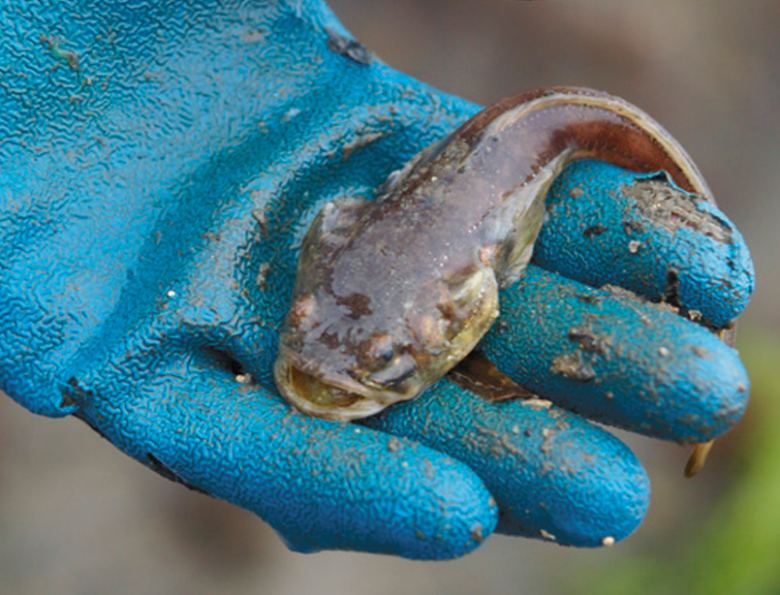Serendipity of the Singing Fish
via the Florida Tech Today
by George White and Christena Callahan
A shared fascination over fish sounds united three biology alumni years and miles removed from their days at Florida Tech. Their research collaboration began before they were even really acquainted.
In 1995, the paths of Allison (Krause) Coffin ’96, Paul Forlano ’97 M.S. and Joseph Sisneros ’99 Ph.D. intersected in the lab of biology professor Tim Tricas. Coffin was a marine biology undergrad in Tricas’ Fish Biology course, supported by graduate assistant Forlano who taught the laboratory. During the same period, Sisneros was pursuing a Ph.D. in the Tricas lab.
“It was in Tricas’ class that I learned how some fish use acoustic cues to communicate, leading to my fascination with fish sound production and communication,” says Coffin.
Their mutual research interest ignited, though it would be years before they became collaborators.
Post FIT, Sisneros and Forlano converged again while studying in the lab of Andrew Bass in the department of neurobiology and behavior at Cornell—where Forlano was a Ph.D. student and Sisneros, a postdoctoral fellow.
“I had the good fortune to follow Paul where we were able to work together on the plainfin midshipman fish, which has become a good model to investigate the neural basis of acoustic communication in all vertebrates,” says Sisneros.
In the subsequent years, the pair collaborated on several projects, which took them to the California coast including Monterey and Tomales Bay areas. They co-authored two manuscripts and a book chapter, including Sisneros’ groundbreaking study published in Science in 2004 that showed for the first time (in any vertebrate) that hormones can affect the frequency sensitivity of the inner ear.
Meanwhile, Coffin had continued graduate studies at the University of Minnesota (M.S.) and the University of Maryland (Ph.D.).
Half a decade later and 1,200 miles from Melbourne, she reconnected with the doctoral student she had likely passed during her undergraduate days in the lab, but never met, Sisneros.
The pair interacted at a Fish Bioacoustics Conference in Chicago.
“We started talking and quickly learned of our FIT connection,’’ she recalls. And, they kept in touch.
In 2007, Coffin started a postdoctoral position at the University of Washington, where Sisneros was an assistant professor.
“I emailed Joe when I arrived on campus and asked to come by his lab to see the fish,” she said. “The rest, as they say, is history.’’
Sisneros invited Coffin to join a midshipman-related project at the UC Davis Bodega Marine Lab, where she spent a week conducting experiments with Sisneros and her former teaching assistant, Forlano.
“It had been years since Paul and I had seen each other,” she exclaims. “I think we both enjoyed working together in a professional setting—a far cry from our initial relationship as teaching assistant and student!”
Today, the trio holds faculty positions—Sisneros at the University of Washington, Coffin at Washington State University, Vancouver, and Forlano at City University of New York, Brooklyn College—and continues to collaborate.
“It would be hard to imagine my life and career without the scientific and collegial connections that started through the Tricas lab and FIT almost 17 years ago,’’ says Forlano.
Coffin concurs, “It’s remarkable that our paths and research interests have intersected so many times over the years, and I look forward to many more years of research, conversation and the occasional happy hour with Paul and Joe.”
And Sisneros agrees. “Both Paul and Alli are not only valued colleagues but also very good friends that I expect to have for the rest of my career,” he says. “The common bond that we share comes from our FIT roots and our shared training, education and love of science that was instilled to us as students at FIT!”
About the Research
Coffin, Forlano and Sisneros collaborate on a curious creature—a singing fish called plainfin midshipman.
Behavior Basics In the spring and summer, the males build nests under rocks in very shallow water, then sing to attract females. Females swim in the shallow water, listen for the males, and pick a mate for spawning.
The Habitat The fish thrive in the cold waters of the West Coast of North America. Fieldwork occurs in coastal estuaries in California and Washington.
Sound Science The colleagues are investigating how female hearing changes seasonally so that her hearing is actually better suited to detect the male mate call during the breeding season than during the winter, non-breeding season. Goals include understanding how hormones influence hearing as well as understanding the cellular and molecular mechanisms of the vocal-acoustic pathway—in other words, what’s going on in the brain when the fish hears sound and when it produces sound.
Listen in Hear the male’s mating call (Courtesy of Dr. Andrew Bass and Margaret Marchaterre)
[audio:http://blogs.fit.edu/wp-content/uploads/2012/07/Midshipman-sound-nesthum.mp3|titles=Midshipman-sound-nesthum]





